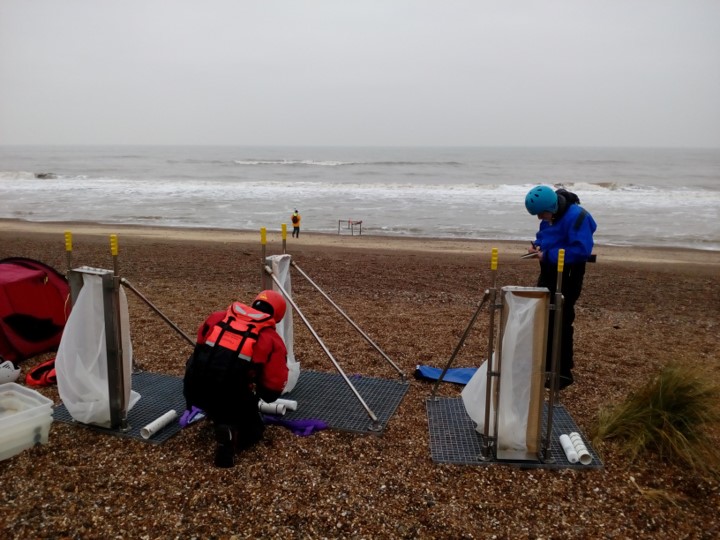Category:Portable streamer traps for longshore sediment transport measurement

Summary
- Measurement of the longshore sediment transport rate in the surf zone remains one of the great challenges in coastal engineering and coastal sciences.
- Streamer traps for sand beaches have proven useful in the past, but are not suitable for Mixed Sand and Gravel (MSG) beaches.
- This category describes a portable depth integrated, streamer trap designed to measure the depth-integrated combined bed load and suspended longshore sediment transport on MSG beaches.
- The device has been tested in the field under moderate wave conditions at Minsmere, UK.
- Empirical efficiency of wave breaking and bed load are several orders of magnitude larger than for uniform fine sand values.
History
Gravel and mixed sand-gravel (MSG) shorelines are common in previously para-glaciated coastal regions and are globally widespread (Buscombe and Masselink, 2006). MSG shorelines are also found where nourishment projects are employed that use sediment size of coarser size than native sediment to protect eroding beaches (Bergillos et al., 2017; Dean, 2003). Using coarser than native sediment results in steeper beach profiles that require less volume of sand to achieve a given beach width. Coarser sediment is also more stable in terms of longshore losses. Despite their worldwide distribution and the growing interest in beach nourishment as an adaptation strategy for combating coastal erosion (Hinkel et al., 2014), sediment transport on MSG beaches is less well understood than on sandy beaches (Van Wellen et al., 2000). One of the key elements in improving the engineer's understanding of beach morphodynamics and sediment budgeting along a MSG coastline is the formulation of a reliable estimate of the total longshore transport rate for feasibility studies of port extensions and appraisals of long-term beach stability. Such estimates should be based on the use of reliable sediment transport models, underpinned by accurate transport measurements. However, field sediment transport-rate data, collected simultaneously with waves and currents that drive sediment transport on MSG beaches, are still very limited.
The portable Streamer Trap (ST) described by Kraus (1987) is one of the few reliable field measurement techniques available to measure the combined bed load and suspended longshore sediment transport at a given point within the surf zone. The ST consists of long rectangular bags of polyester-sieve cloth material (100 μm) vertically mounted on a stainless steel rack. An operator standing down-current attends the trap during a sampling interval of about 10 min. The use of these traps is restricted to shallow water (<1 m) with wave heights less than about 0.5 m. Researchers have used STs mostly to measure sand sediment transport (Kraus, 1987; Wang, 1998; Wang et al., 1998; Kumar et al., 2003; Tonk and Masselink, 2005; Allen, 2012), with only one reported use on an MSG beach (Dawe, 2006). Dawe (2006) has shown that Kraus’ ST design is operationally effective in the swash zone of the MSG shoreline at Lake Coleridge, New Zealand. The ST was able to stand unattended for most of the 500 h measured, where wave heights averaged 0.20 m–0.35 m, wave periods were 1.43 s–2.33 s and water depth was 0 m to 0.5 m. Most commonly, the trap was in place between 1 min and 5 min. The weight of material collected in the trap ranged from as little as 0.1 kg though to 5.5 kg, with a sediment size variation of between 1 mm and 10 mm (d50).
Chadwick (1989) conducted seven successful trapping experiments at Shoreham, UK, using a different sediment trap design than the suggested by Kraus (1987), registering transport rates from 4 to 32 m3/day for waves of between 0.23 and 0.48 Hrms and d50 of 20 mm. The surface mounted shingle trap used by Chadwick (1989) consists of a right triangular prism frame where all faces except the top (which was open), were made of a mesh that allows the water to flow through and trap the coarse material. The frame is orientated to trap longshore sediment transport (i.e. need to anticipate the main direction of the longshore sediment transport) and is anchored to the ground with pins. The trap is left unattended during a full tidal cycle (i.e. several hours). Bray et al. (1996) found that the trap design used by Chadwick was difficult to secure in loose shingle and, therefore, few measurements could be made in areas where sediment mobility was highest. Overall, they found that the trap volumes were several orders of magnitude lower than measured by tracers. They attributed these differences on trapped volumes due to scouring, build-up against the sides of the trap, and loss of material on the ebb tide. They concluded that surface mounted shingle traps are unreliable in conditions other than near-calm.
In this category, we present a new portable streamer trap to measure point-Depth-Integrated Longshore Sediment Transport (DIST) on MSG beaches. It was first developed in 2020[1] with the aim to investigate the field performance of the device under moderate wave conditions (i.e. wave heights less than 1 m). To test the performance of the device, we compare measured to simulated rates using the depth-integrated and wave averaged cross shore numerical model CSHORE (Kobayashi, 2016). During the experiment, offshore wave forcing was measured by a directional wave buoy located about 4 km seaward of the study site. Current velocity and water levels were measured with an Acoustic Doppler Velocimeter (ADV) and a pressure sensor anchored to a fixed rig, which was well within the surf zone during the full tidal cycle. A pressure sensor was also attached to the portable streamer trap to provide information relative to water depth and water surface elevation at the trap location.
References
This category currently contains no pages or media.